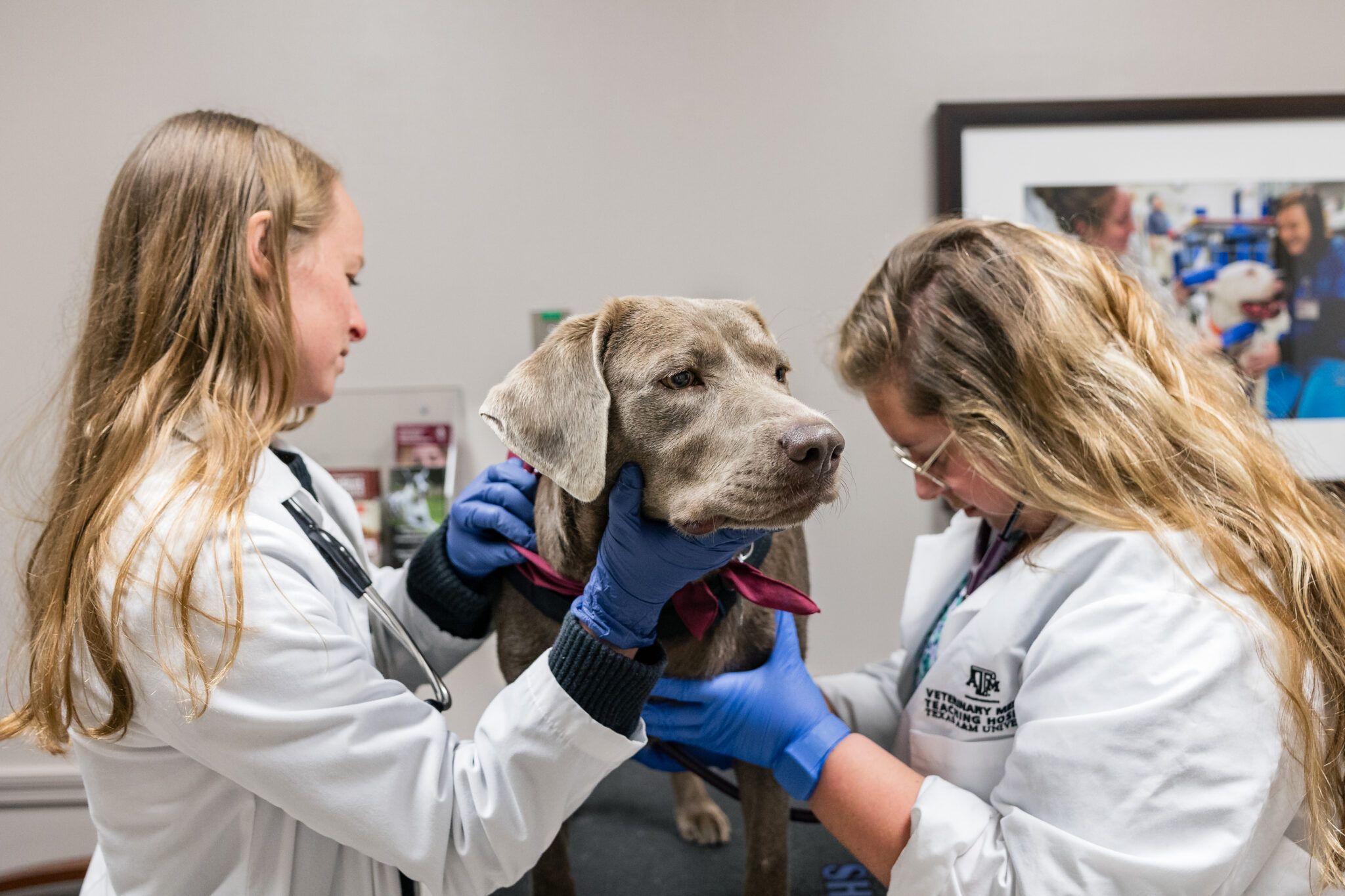Dog receives rare autoimmune disease diagnoses
Lanie, an English silver Labrador retriever, was diagnosed with 3 autoimmune diseases
Lanie, an English silver Labrador retriever, being examined by veterinary professionals at the Small Animal Teaching Hospital at Texas A&M (Image courtesy of Jason Nitsch ’14, Texas A&M Division of Marketing and Communications)

Lanie, an English silver Labrador retriever, was an exciting addition to Anthony and Clara M. Simpson’s family. The duo decided to adopt a dog after Anthony’s work travel increased in 2022 so the family traveled to Ardmore, Oklahoma, where they picked up Lanie, and became bonded very quickly.
However, about a month after Lanie was brought home, the pair noticed that was more lethargic and uninterested in everything, which is uncommon for a puppy of her age. The Simpsons were worried about Lanie’s health so they brought her to the Gulf Coast Veterinary Specialists (GCVS), where the team diagnosed her with 2 autoimmune diseases, Juvenile Cellutis (puppy strangles) an uncommon granulomatous and pustular disorder of the face, pinnae, and submandibular lymph nodes that typically affects puppies up to 6 months of age,2 and Hypertrophic Osteodystrophy (HOD), an auto-inflammatory disease of the bones.
“Dr Rhonda Dixon, the doctor who treated Lanie at GCVS, is a Texas A&M alumna,” said Clara Simpson, in an organizational release.1 “She was incredible and diagnosed Lanie after just one day and said that having puppy strangles and HOD at the same time was a very rare thing. Even so, she reassured us that both issues were treatable, and we were able to bring Lanie home soon after.”
What is wrong with Lanie?
After these diagnoses, the family returned home and settled into their daily lives with a healthy Lanie. On September 9, 2023, Anthony Simpson recalls noticing Lanie could barely open her mouth. They rushed her to a local emergency clinic, where they ruled out her eating something she should not have, but the family had no answer to what was happening to Lanie.
Clara Simpson explained that the emergency veterinarian treating Lanie recommended they take her to Texas A&M because they have a staff of veterinarians with a wide range of specialties and if the staff there cannot help her, they can help find the people who can. The next day, the Simpsons brought Lanie back to Texas A&M.
Lanie experienced severe swelling as her team tried to find a diagnosis in order to treat her (Image courtesy of Chanel Berns, DVM)

After being examined by the Small Animal Teaching Hospital at Texas A&M (SATH) emergency and critical care service team, they referred her to Jessica Herman, DVM, a resident of the small animal internal medicine service. The next evening, September 10, 2023, Lanie’s neck and face began to swell and continued to swell throughout the week, putting a rush on finding a diagnosis.
“It was up to us to try and establish the underlying cause of the swelling and fever she was experiencing,” Herman said. “The difficulty in this diagnosis lies in the location of her swelling, which was under the chin, where we have salivary glands, nerves, blood vessels, muscles, lymph nodes, and more; it is a very busy area that participates in supporting and moving the head, chewing, swallowing, breathing, and talking — or, in Lanie’s case, barking. We had to figure out if her swelling was a tumor, an abscess, or a foreign body like a sock.”
A rare diagnosis
The first move to diagnose Lanie was to perform a CT scan so the team could look at her neck and head, which helped them figure out where the swelling was located internally. The team then brought in the small animal radiology team to help collect samples from the swollen tissue as the tissues continued to grow. Lanie’s next step was to receive a surgical biopsy from Chanel Berns, DVM, a fourth-year surgical resident.
“When I performed the surgery, it was clear that her lymph nodes were the problem,” Berns said. “They were swollen to about 7 centimeters, whereas, typically, lymph nodes are less than a few centimeters.”
Once the biopsy was done, and Berns consulted with the senior clinician Genna Atiee, DVM, DACVIM (SAIM), the team was able to provide Lanie’s family with a diagnosis: Canine sterile steroid-responsive lymphadenitis. Canine sterile steroid-responsive lymphadenitis is considered in dogs with pyrexia of an unknown origin with inflammatory lymphadenopathy in the case of there being no underlying cause that can be found, and the dog responds well to immunosuppressive corticosteroid therapy.3
“When we break down the words in her diagnosis, it’s easier to understand how her experience with puppy strangles led to her third autoimmune disease,” Berns said. “Sterile means there’s no underlying infectious disease, so no bacteria or fungus. Steroid-responsive means that all the swelling she had would clear up with proper steroid treatment. And lymphadenitis just means swelling of the lymph nodes.”
“So, in short, she had swelling that wasn’t being caused by an ongoing infection but, rather, likely resulted from her experience with puppy strangles. Her body was trying to fix a problem that didn’t exist and triggered a new autoimmune response,” she continued.3
Herman also explained that this diagnosis is similar and could be related to the puppy strangles because these diseases often come together.1 The team decided on the best steroid treatment for her condition and noticed a rapid reduction of the swelling once applied.
Heading home
Lanie stayed at SATH for a week before heading home where she will finish her treatment. She is currently back walking at the neighborhood park with her family, eating her favorite food, and sharing her story around the world.
“I don’t think that there will ever be enough words to tell her Texas A&M veterinary team how grateful we are,” Clara Simpson concluded. “I’ve always heard that you should take your pets to Texas A&M and to make sure that your vet is an Aggie veterinarian. And now that we’ve experienced their level of care and compassion, we get it — 100%. We have seen firsthand how they treat the families and the animals under their care — they understand that they’re more than pets; they’re family.”
According to the release,1 Lanie has since made a full recovery.
Reference
- Texas A&M veterinarians diagnose rare autoimmune disease, put dog on road ro Recovery. Texas A&M. March 19, 2024. Accessed March 22. 2024. https://today.tamu.edu/2024/03/19/texas-am-veterinarians-diagnose-rare-autoimmune-disease-put-dog-on-road-to-recovery/
- Hutchings SM. Juvenile cellulitis in a puppy. Can Vet J. 2003;44(5):418-419.
- Ribas Latre A, McPartland A, Cain D, et al. Canine sterile steroid-responsive lymphadenitis in 49 dogs. J Small Anim Pract. 2019;60(5):280-290. doi:10.1111/jsap.12980
Newsletter
From exam room tips to practice management insights, get trusted veterinary news delivered straight to your inbox—subscribe to dvm360.